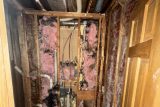How To Keep Moisture Out Of Your Home
Homeowners
4 years ago

Controlling moisture in your home is an important part of keeping your home safe and structurally sound.
Moisture control can be difficult in older homes due to older windows and doors, inadequate insulation, and poor ventilation.
Too much moisture in your home can quickly lead to problems like mold, mildew, pest infestations, and even structural damage. Learn to recognize the signs of excess moisture and how to fix them!
Musty Smells
Mold can result in a strong musty smell, while mildew is usually a little less noticeable. If any space in your home smells “damp”, it can be a sign of mold or mildew being present.
Since mold can develop in hard-to-see or reach areas, detecting it through a musty smell can be an early sign.
Visible Mildew (Or Mold)
Visible mold or mildew spots in your home are an obvious sign of high moisture in your home. Common places to find mold in your home are in the basement, crawlspace, bathroom, or kitchen.
There are many types of mold and some are more dangerous to your health than others. If you see mold or mildew in your home, contact us immediately and we can help you through the restoration process.
Doors & Windows That “Stick”
The windows and doors in your home should open and close easily, without the use of excessive force. If it’s becoming difficult to close the doors in your home or your windows all of a sudden don’t want to slide open easily, it could be due to high moisture warping those areas.
Peeling Wallpaper Or Paint Bubbles
Wallpaper and paint can peel or bubble due to age, and that’s to be expected. However, if you’ve recently painted or wallpapered your home and are noticing peeling and bubbling, that could be a problem!
This is most often an issue in bathrooms with poor ventilation, where the humidity from showers and baths can cause wallpaper to peel.
Warped Floorboards
If you have hardwood flooring, be aware that they can be extremely responsive to changes in humidity in your home. If your floorboards have started to swell, separate, crack, or come loose, it might be a sign that there is too much moisture in your home.
Ceiling Water Stains
Have you noticed a brown, yellow, or just slightly darker shade than the paint on your ceiling? These stains are made by water, usually a leaking pipe in the ceiling. You never want to paint over a stain like this without investigating the cause of the water stain.
Water damage in your home can be serious, and only gets to be a larger problem if you ignore it.
Moisture Control Is Vital To Keep Your Home Safe
If you’ve noticed any of the signs listed above in your home, it’s worth investigating. Ignoring these early signs of moisture damage can cause more severe problems and put your family’s safety at risk.
Lake City Restoration Is Here To Help
Most of these moisture problems aren’t safe to explore and address on your own. Our restoration experts are here to use our knowledge and expertise to help you find the right moisture control solutions.
If your home has been more seriously damaged by water or moisture being present, we can help you navigate that restoration process too!




